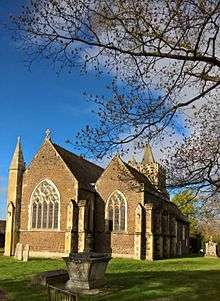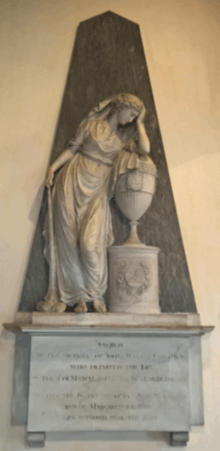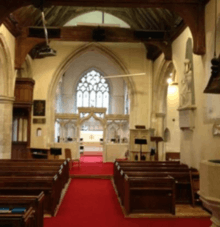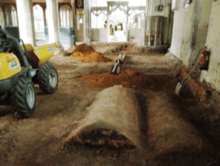Warfield Church

Warfield Parish Church is a grade II* listed building. It is located on Church Lane, Warfield in Berkshire, England, ¾ of a mile north-east of the modern centre of the vlillage. It is named after the archangel Michael. The area around the church has been designated a conservation area since 1974 primarily to protect the character and nature of this historical building.
Pevsner commented that, "Warfield is one of the most rewarding churches around".[1] The building charts its origins back to 1016 when Queen Emma, the wife of King Æthelred the Unready decided to give "the vill and chapel" of Warfield to the See of Winchester.[2] Although it is likely that the location where Warfield Church now stands has been a place of worship from approximately 800AD when it was little more than a clearing in the middle of the Windsor Great Forest. "Warfelt" is mentioned in the Doomsday Book of 1086. In 1087 under the reign of William II, The Priory of Hurley was given patronage of Warfield, i.e., the right to appoint the Vicar. This patronage continued until 1535.[3]
The early years
The first stone church was constructed in Warfield c. 1135 under King Stephen. The church building would have been a simple timber construction before that. In 1156 Henry II signed an official charter giving the lands and church of Warfield to the Monks of Hurley.[3]
In 1272 in the reign of Edward I a new chancel was built on the site of the present day St Katherine's chapel and glass started to be used in windows. At this date the Eucharist was only taken three times a year and all services were in Latin. In 1349 the Black Death hit Warfield. Until that point the village of Warfield was in close proximity to the church. The Black Death caused people to leave homes close to the church and relocate further afield. This explains the church's slightly isolated location today.
The monks of Hurley
At the end of the 14th century the monks of Hurley moved to Warfield because the Thames flooded their priory in Hurley.[4] The 14th century monks were formidable.[5] They took over the Parish Church, probably using the Chancel, today's St Katherine's Chapel, as their Chapter House. They built a fine Chapel (today's Chancel) as a scaled version of that at Hurley, the chalk having been brought from the Hurley chalk pits. The monks gathered for corporate worship six times a day. Following the repair of Hurley in 1401 the monks began to return to their home besides the Thames.[6]
Several decades after the monks returned to their Priory on the Thames, the major part of the building at Warfield was constructed out of what the monks left behind. The Tower was built in the mid 15th century and the present bell tower was completed. In the 1500s the picture of the Church would have been one of priest with his helpers in the chancel, dressed in colourful robes, speaking hardly audible tones in Latin.[7] Across the entrance to the Chancel was a large wooden screen with statutes on it.[4] A restored version using some of the original carving is across the entrance to St Katherine's Chapel today. The walls were highly painted with pictures and texts.[8]
In 1523 Robert Geyn was appointed Vicar of Warfield. At the Bishop's visitation of 1550 the people complained that Geyn was not performing his duties, had employed an untrained curate (Robert Mason) to care for the church, and was using the vicarage to care for horses and pigs.[3]
The Protestant reformation
In 1570 the Warfield Parish Rooms were built. It was known as the Wake House. People used to meet annually on the feast of the dedication of the church to St Michael. The building is possibly on the site of an older monastic building.[6]
There is always some item of background controversy however, in 1674 the Warfield Wardens state that the present vicar had given up teaching and had become a farmer. In 1677 there was a yearlong lawsuit between John Brakes (a parishioner) and the Warfield Church Wardens as to the ownership of the pew by the pulpit.[3]
The 16th and 17th centuries saw vast changes. Henry VIII's break with Rome led to the destruction of the monasteries and priories. Local churches like Warfield were also cleansed of all things that could lead to ritual and superstition. The walls were whitewashed and screens and statues would have been removed. The stone altar was also removed and replaced by a simple wooden table. There was also a large two decker pulpit.[9]

Memorials
There are many memorials adorning the walls of St Michaels covering many centuries. The one shown to the left dates from the mid 18th century and is a memorial to a wife, husband and a child who died in infancy. It was only during the excavation work for the new floor in the 21st century that the nature of this memorial was realised. Almost directly beneath the memorial were found the coffins of two adults and a child. They remain unmoved - the new floor placed on top. The 1700s saw the building filled with private pews but this did not lead to high attendance. In the 1780s according to the parish records the average at Communion was less than 15 with just over double that at festivals.[10]
The Oxford Movement
By the early 19th centurys there was an active Sunday School owing much to the model created by Robert Raikes the editor of the Gloucester Journal.[11] In 1843 the Vicarage was burnt down, and the Vicar emigrated with the funds for the new vicarage.[12]
In 1851 Warfield parish changed for the first time on record to create a Parish of Bracknell with its own church, Holy Trinity.[13] In 1860 William Cocks wrote an account of Warfield church. He describes box pews, whitewashed ceiling, and a gallery across the back with a barrel organ given by Lady Jane Walsh.[14] There was a two-deck pulpit, and the farm workers sat at the back on benches. The west gallery later to be known as the "Ormathwaite gallery" was entered by a stairway from inside the church, where his Lordship sat with his servant.[15]
Many were concerned that the Church of England had lost its way and in the 19th century two movements arose to remedy this. One of these was the Oxford Movement with its attempt to take the Church back to its medieval sense of mystery. The Warfield Church began a journey down a more Roman Catholic form of worship.[16]
George Street
In keeping with this journey down a more Roman Catholic path, in 1874 George Street was invited by the then Vicar to redesign the building. Street's plan would involve vast work.[17] The box pews were removed, as was the old wooden pulpit, as well as the large window above the main aisle. In went new stone work, the wooden screen across the Chapel entrance, new pews, and a new porch.[18]

The then Vicar had used the years since 1860 to collect funds for such a venture, but Lord Ormathwaite was upset that his gallery was to be removed.[19] A compromise was reached and the Ormathwaite pew was eventually placed at the front by the lectern. On acceptance of the plans, services moved to the Parish Rooms for the next three years. The majority of the restoration work was completed and the church reopened on Tuesday, September 26, 1876. Services on that day were 8:30 am Communion, 11:00am Morning Service, and 4:00pm Evening Service. The church was filled for all services with a very large number of visitors. The Bishop of Oxford presided over the day. The total cost for the work was £3,060 of which £2,250 had been raised locally.[19]
The church was dedicated to St Michael and All Angels.[20] The work involved the removal of the ceiling, box pews, west gallery, the installing of new seating, stone pulpit, and stone font. These items remain in the building, all be it in new locations after the early 21st century renovation.
The 20th Century

In 1982 Brian Meardon was appointed vicar and under him the church took on a more Charismatic emphasis, the Choir was disbanded and choir pews removed from the chancel. Towards the end of the 20th Century red carpets were fitted in the church and a balcony added - although no additional stairs were added, so access to the balcony was still via the stone bell tower steps and through the ringing chamber.[21]
Under Brian Meardon, St Michael's planted two new Churches into Warfield; All Saints and St Peters and once into Bracknell; Eternity Bullbrook.[10]
Into the 21st century
Revd Canon Dr Brian Meardon retired in 2009 and a year later Revd Dr Mark Griffiths JP, Warfield's 50th Vicar, was appointed.

2013 saw a major renovation taking place at the Parish Church of St Michaels. St Michael's was beginning to see higher attendance,[22] and the Warfield population was increasing[23] therefore the building needed to be made fit for the demands of the 21st century. The floor was completely removed (revealing many lead coffins which were left as they were found), and underfloor heating was installed along with a new Purbeck Stone floor. The pulpit was moved from near the South Transept to a position in front of St Katherine's Chapel. The font was moved from the back of the nave to a position besides the north door. The balcony installed to replace the organ loft was removed as was the narthex. Pews were taken out and replaced with chairs. The overall cost of the project was close to £500,000. The amount was raised through donations from the church membership and wider Warfield community.

During the period of the reordering the St Michael's congregations met at St Andrew's Priestwood. St Andrews was part of the parish of Holy Trinity Bracknell but its numbers had reduced significantly over the past decade.[24] In 2014 Warfield Church was asked to take over St Andrews Priestwood and the parish boundary was adjusted to make this possible. In effect St Andrews became Warfield Church's fifth church plant. Its fourth was into Bracknell two years earlier when it planted Mosaic Bracknell.[25]
2016 marked the thousand-year anniversary of Warfield Church.
References
- ↑ Pevsner, Nikolaus (1966). Berkshire: Buildings of England Series (Pevsner Architectural Guides) (Pevsner Architectural Guides: Buildings of England). Yale. p. 257. ISBN 030012662X.
- ↑ Page, William (1923). A History of the County of Berkshire: Volume 3. London: Victoria County History – via British Museum Archives (online).
- 1 2 3 4 Barty-King, Hugh (2001). Warfield: A Thousand Years of a Berkshire Village. Berkshire: Warfield Parish Council.
- 1 2 Wethered, Rev F T (2005). Land and Tythes of Hurley Priory. Forgotten Books. ISBN 133231046X.
- ↑ "Medieval Monks".
- 1 2 Caines, GJP (1879). "Warfield Church and Parish". Berkshire Archaeological Journal.
- ↑ Haigh, Christopher (1993). English Reformation: Religion, Politics and Society under the Tudors. Oxford University Press. ISBN 0198221622.
- ↑ English Heritage Archives
- ↑ Bernard, G (2007). The King's Reformation. Yale. ISBN 0300122713.
- 1 2 "Church of England Archives".
- ↑ Griffiths, Mark (2009). One Generation from Extinction. Lion Hudson. ISBN 1854249290.
- ↑ Ditchfield, P. (1896). Bygone Berkshire. E. P. Publishing. ISBN 0715811339.
- ↑ Page, W. (1926). A History of the County of Berkshire: Vol 3. Victoria County History – via http://www.british-history.ac.uk/vch/berks/vol3.
- ↑ Letters of Lady Jane Walsh - The National Library of Wales
- ↑ "Reading Mercury Berkshire". Reading Mercury Berkshire. 1851 – via Newspaper.
- ↑ Nockles, Peter (2008). The Oxford Movement in Context. Cambridge University Press. ISBN 0521587190.
- ↑ Elliot, John (1998). G E Street: A Victorian architect in Berkshire. University of Reading. ISBN 0704913305.
- ↑ Nash-Ford, David (1996). "Warfield". Royal Berkshire History.
- 1 2 "Parishes: Warfield".
- ↑ The Diocese and Victorian Society refers to it as St Michael and All Angels. Locally, and by English Heritage it is known as St Michael the Archangel. Although registers dating back to 1650 mention the latter, so I suspect the locals have got it right.
- ↑ "Warfield Bellringers".
- ↑ Warfield Church Parish Records 2010-2013 logged at Church House Oxford
- ↑ "Population Statistics - Warfield" (PDF).
- ↑ Parish Records - Bracknell Team Ministry - Records logged at Church House Oxford
- ↑ "Mosaic Bracknell".